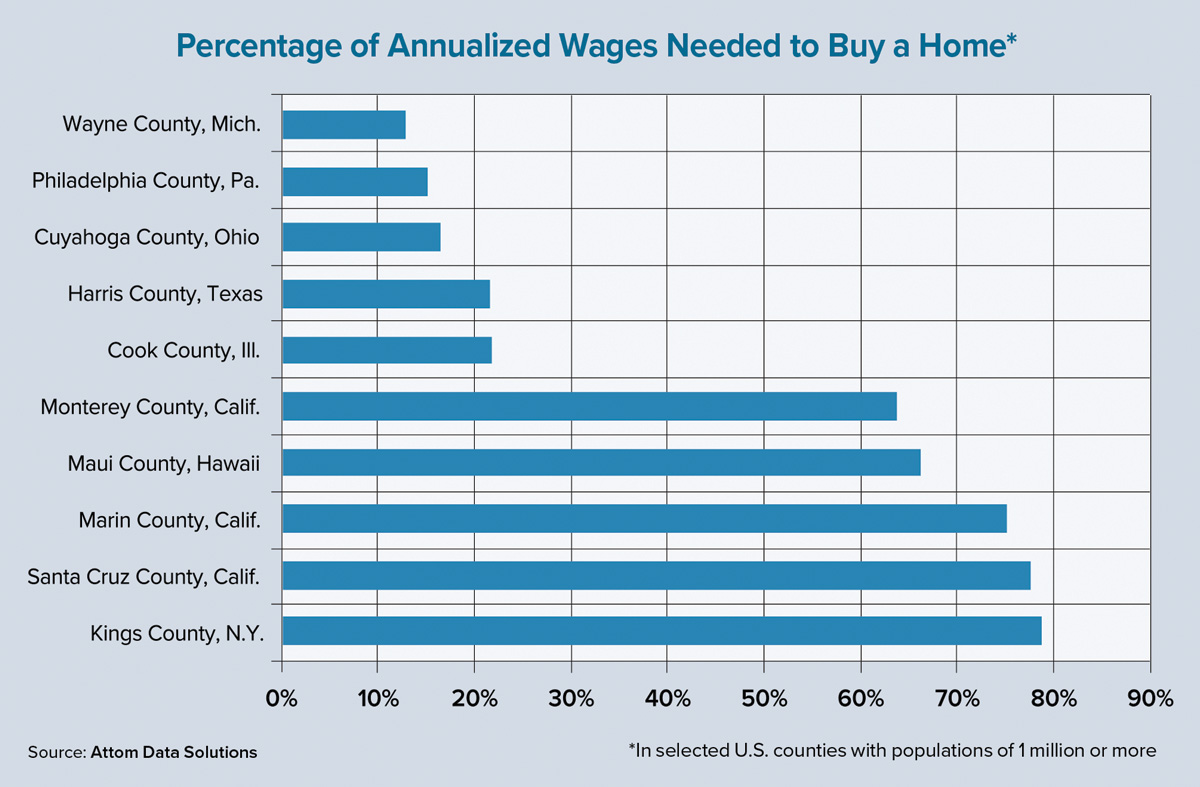With home prices across the country continuing their sharp rise, affordability is becoming a bigger issue for prospective homebuyers. According to Attom Data Solutions’ third-quarter 2021 U.S. Home Affordability Report, a median-priced single-family home was less affordable at that time than historical averages in 75% of the counties analyzed, the highest share in 13 years. This was a significant increase from 56% in third-quarter 2020 as home-price increases quickly outstripped wage increases in many parts of the nation.
In Q3 2021, the median U.S. home price shot up year over year by 18% to a record high of $315,000. The major ownership costs (including the mortgage, taxes and insurance) on a typical home consumed 24.9% of the average U.S. wage of $64,857. This figure rose by 60 basis points on a quarterly basis, but the difference is much starker compared to Q3 2020, when these expenses were only 22.3% of the average wage.
The 24.9% figure was still within the standard 28% debt-to-income (DTI) ratio that many mortgage lenders prefer, but affordability is becoming incrementally worse as national DTI levels inch toward unaffordable ranges. Interest rates that remain near historic lows are helping to keep homeownership within reach, but wages are struggling to keep up with surging home prices.
In fact, home-price appreciation was greater than weekly wage growth this past third quarter in a whopping 75% of the 572 counties analyzed in Attom Data’s report. Unsurprisingly, some of the country’s most-populous cities had the largest gaps between home-price growth and wage growth. These included the core counties of the Los Angeles, Phoenix, Miami, Dallas and Houston metro areas.
Large metro areas also are home to counties where wage growth is outpacing home-price appreciation, although this may be connected to a number of factors, such as slower home-price appreciation due to already high values. In Q3 2021, wages grew faster than home prices in Cook County (Chicago), Illinois; and the highly populated California counties of San Diego, Orange, Santa Clara and Alameda.
Although affordability was decreasing in comparison to historical averages, home prices were still considered affordable in 53% of the counties analyzed. These included the core counties of the Chicago, Houston, Dallas, San Antonio and Detroit metro areas. Meanwhile, among the 47% of counties where housing costs were deemed unaffordable (by consuming more than 28% of the average income), the most populous include Miami-Dade County, Florida; Maricopa County (Phoenix), Arizona; and the California counties of Los Angeles, San Diego and Orange.
Location remains a critical factor in affordability. Large, coastal metro areas continue to frustrate attempts at affordable homeownership as price gains devour increasingly more income. But there’s a huge difference between the 28% DTI standard of affordability and the costs of buying a home in the five least-affordable U.S. counties. Tops on this list is Kings County (Brooklyn), New York, where 78.7% of annualized weekly wages is needed to buy a home. Rounding out the top five are Maui County, Hawaii, and the California counties of Santa Cruz, Marin and Monterey, where this ratio is 63.7% or higher.
For potential homebuyers with flexible locations due to the rise in remote work during the pandemic, there are bargains to be had. For example, in Schuylkill County, Pennsylvania (outside Allentown), buying a home requires only 9.5% of annualized weekly wages. Pennsylvania has two other counties outside Pittsburgh (Fayette County at 10.6% and Cambria County at 10.9%) where the wage-to-price barrier is significantly low. Macon County, Illinois (11.3%), and Bibb County, Georgia (11.4%), also cater to affordable homeownership.
For bargain hunters looking for homes in metro areas with a population of at least 1 million, counties in the Detroit, Philadelphia, Cleveland, Houston and Chicago metro areas stand out. The percentage of annualized weekly wages needed to a buy home in these areas range from 12.8% in Wayne County, Michigan, to 21.8% in Cook County, Illinois.
There’s no question that affordability has tightened across the nation when it comes to buying a home. Whether this will improve or worsen is largely uncertain as the COVID-19 pandemic drags on and its effects on the U.S. economy continue to be felt. ●
-
Todd Teta is chief product and technology officer at Attom Data Solutions, where he leads the company’s technology and product teams. Prior to joining Attom Data Solutions, Teta led the product-development and technology organization at Meyers Research. Teta also previously co-founded several startups, including VisionCore, a company serving the mortgage and real estate data and analytics markets that was later sold to CoreLogic. He is a graduate of the University of Southern California, where he earned a degree in computer engineering and computer science. Learn more about Attom Data Solutions at attomdata.com.
View all posts







